top of page
Search
Hallo, Berlin!
I land in Berlin Brandenburg Airport around 6pm local time on Monday 4th September, with only an hour's delay. The ride was smooth and I...
Sep 5, 20232 min read


Immersion and the Sublime in Video Games: Environmental Awe from Romanticism to The Legend of Zelda: Breath of the Wild
Abstract Drawing from art history, game studies and the aesthetic philosophies of Immanuel Kant and Edmund Burke, I argue that in their...
Jun 21, 20231 min read


Reference photos from Italy
I sit in Edinburgh Airport, awaiting my bus back to Dundee. I return from Italy, where I saw my family and brought my boyfriend to meet...
Apr 16, 20222 min read


Gender Performativity and Sexual Difference
In their 1990 book Gender Trouble ¹, Judith Butler argues that gender is performative: its norms develop through mimesis, as well as...
Apr 15, 202216 min read


Level 3 Semester 2 Life Drawing
I attended the life drawing classes again this semester and really enjoyed myself. I didn't go to as many, but I really feel like I'm...
Mar 27, 20222 min read


Starting a still life
In my open tutorial with Janice a few weeks ago, we discussed how I might practice painting with thicker strokes. This is something I...
Feb 27, 20222 min read


Etching of DJCAD
I mostly worked on the DJCAD etching this week. I had to be more meticulous this time since, as I’m depicting a piece of architecture,...
Feb 20, 20222 min read


Preparing an etching
This week, I started an etching of DJCAD. I chose the subject matter for my Dad’s birthday, as he did his postgrad at the college back in...
Feb 13, 20222 min read


A couple film reviews
I went to see a couple films at the DCA this week. This is something I would like to get into more, as it’s both fun and a good way to...
Jan 30, 20222 min read


Getting the ball rolling again
After last semester, I wanted to amp up my work rhythm. As such, I set myself the task of having multiple pieces on at once. The first...
Jan 23, 20221 min read


Life Drawing
As I did last year, I wanted to give an update on my life drawing this semester. This would be a good way to put my research journal to a...
Dec 5, 20212 min read


Itching for an Etching
As I mentioned in a previous post, I have really wanted to get into etching since last year. This was first suggested to me by my tutor...
Nov 28, 20212 min read
bottom of page